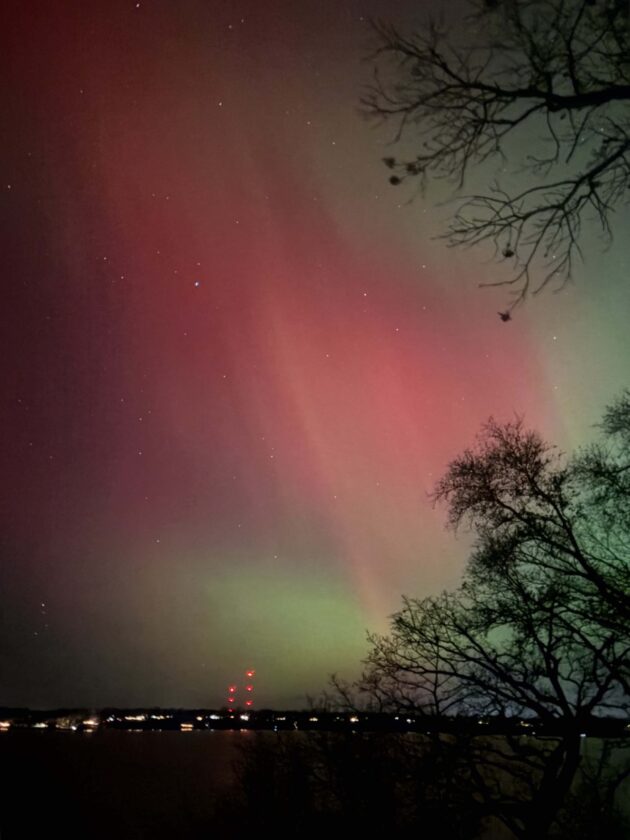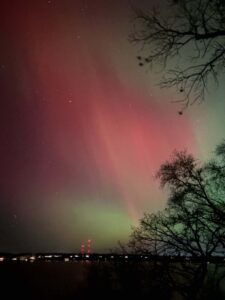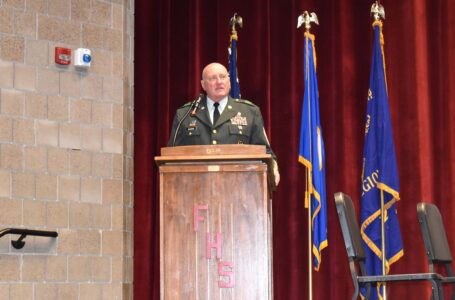Region experiences colorful weather phenomenon

ABOVE: Aurora borealis, or northern lights, visible over Hall Lake in Fairmont on Tuesday night. There could be a second showing tonight. Photo by Brooke Wohlrabe
FAIRMONT – Like thousands across the state, Fairmont experienced a vivid amount of aurora borealis, northern lights, on Tuesday, and could get a second showing tonight.
National Weather Service (NWS) Lead Forecaster Mike Griesinger said northern lights are a result of the Earth’s magnetic field interacting with charged particles that get ejected from the sun and come out into space.
This event came from a geomagnetic storm that reached G4 severe levels, just one level below the highest possible of G5. Griesinger said this resulted in solar flares.
“We had three strong solar flares, Sunday, Monday, and then Tuesday as well,” he said. What we got [Tuesday] night looks like it was kind of a combination of the Sunday Monday, where Monday caught up to Sunday, and so the energy from those two solar flares came through last night. Somewhere out in space, quickly heading toward us [Wednesday] is the solar flare that left the sun yesterday.”
While a geomagnetic storm can cause disruptions, Griesinger said he has not heard of any concerns in that department.
“Last night’s was a pretty strong one,” he said. “Changes in the magnetic field can lead to some surges in the power grid, but none of that happened. That would be the biggest potential negative impact we could see from a strong solar storm.”
The response NWS got was not of concern, though. Instead, Griesinger said they got a barrage of photos from eager photographers who sought to capture their own little piece of the event and share it with the weather service.
When it comes to northern lights, Griesinger said the sun goes through cycles with sunspots, and it is currently at its peak for sunspot activity. With this, Griesinger said northern lights activity is more common now, but will start to get less and less so as the sunspot cycle comes down from its peak.
“We’re on the downward trend now,” he said. “We might get into something like this again in basically 20 years, because of the fact we’re still near that peak of the solar activity. We’ll start to start quiet down here in the next couple of years, and we’ll bottom out in about 2035, and then we should peak again about 2046.”
Tuesday was not the end of their focus either, as they were still on the lookout for another coronal mass ejection brought by a solar flare Wednesday, and made seeing more aurora borealis possible.
“There’s a strong possibility that they’ll be out again tonight,” Griesinger said. “We’re just watching to see with satellites that we have, as we have satellites to essentially observe solar weather and solar wind.”
After Wednesday, Griesinger said it will be much less likely further flares and ejections bring northern lights.
As for the overall weather, he said there is a warm spot for the next few days.
“We got warmth,” Griesinger said. “50s, 60s, maybe a 70 down by Fairmont on Friday. We’ve got a cold front coming on Saturday, and that’ll start to push our temperatures back down during the day on Saturday, and then Sunday into next week looks like near normal temperatures. You’ll see highs more in the 40s then, as opposed to the 50s and 60s you’re going to see the next few days.”



